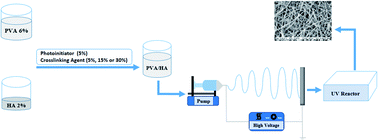Water-based synthesis of photocrosslinked hyaluronic acid/polyvinyl alcohol membranes via electrospinning†
Abstract
Electrospinning is a versatile and low-cost technique widely used in the manufacture of nanofibrous polymeric membranes applied in different areas, especially in bioengineering. Hyaluronic acid (HA) is a biocompatible natural polymer, but it has rheological characteristics that make the electrospinning process difficult. Thus, its association with another polymer such as poly(vinyl alcohol) (PVA) is an alternative, as PVA has good rheological properties for electrospinning. Based on this, the aim of this work was to produce, by the conventional electrospinning method, cross-linked HA/PVA membranes free from organic solvent with a low degradation rate in PBS 7.4 solution after the photocrosslinking process and without using any organic solvent. The results showed that the electrospinning occurred effectively for all conditions tested, but the best result for complete cross-linking only occurred with 15 and 30% crosslinker, which was evidenced by infrared spectroscopy. The addition of crosslinker favored the stability of the electrospinning jet, especially for 30% crosslinker concentration. The membranes did not show cytotoxicity even after the cross-linking process, which indicates that the material has potential as a drug delivery device.



 Please wait while we load your content...
Please wait while we load your content...